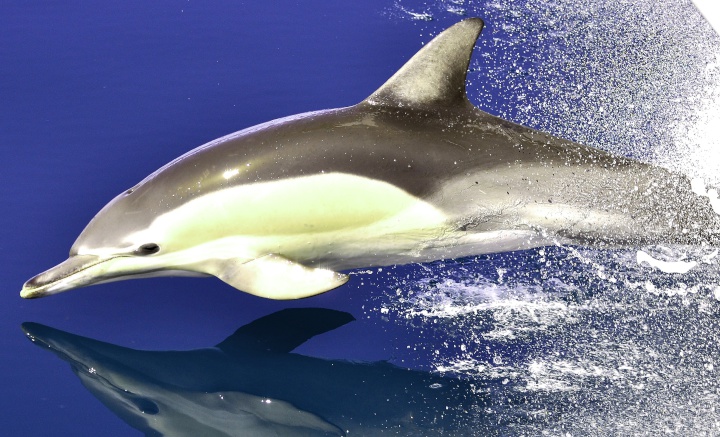Know your dolphin by the fin, says NIWA scientist
Know your dolphin by the fin, says NIWA scientist
Identifying dolphins using photos of the unique pigment
patterns on their fins can be used to help in the management
of a species, says a NIWA scientist.

Cetacean biologist Dr Krista Hupman is the lead author of two new scientific papers outlining an accurate method of counting dolphins by using photo identification. “We have photographed individual dolphin’s dorsal fins and established a catalogue of dolphins that can be differentiated by differences in their dorsal fin edge markings and pigmentation patterns,” Dr Hupman says.
Scientists use catalogues of animals to determine how many animals occupy a region and such information can be used to determine if the population is in decline.
However, some dolphins can be hard to count as they occur in large populations, over vast areas and may lack distinctive markings for identification. It is for these reasons that many scientists shy away from using photo-identification to conduct population estimates, and instead use aerial or shipboard surveys.
Dr Hupman says these methods may not be the best for counting animals and limit our ability to learn about individual animals.
“It’s really hard to know how many dolphins there are of some species, because they travel over large distances and don’t have any distinctive markings. We’ve developed a reliable photo-identification method that challenges how dolphins are counted that could have significant impact on the management of these animals.”

Dr Hupman says there is a way to use photo-identification to estimate the number of poorly marked dolphins, but it involves establishing new methods such as using dorsal fin pigmentation patterns for individual identification.
From 2010-2013, Dr Hupman and a team of researchers collected more than 240,000 images of dolphins in the Hauraki Gulf at different times of the year. From this vast number of photographs, almost 31,000 were deemed of sufficient quality to use in the identification process.
They were compared manually using nicks and notches and pigmentation patterns. That resulted in 2083 unique individuals being identified.
“This study formed the largest catalogue of common dolphins worldwide which is a significant achievement for everyone involved in this project.
“This is also the first study using photo-identification to determine the abundance of a large population of dolphins and demonstrates it is possible for species with little distinctive markings. The combination of dorsal fin edge markings and pigmentation patterns provided a robust method for individual identification.”
Identifying dolphins solely by the pigmentation on their dorsal fins had been thought to be unreliable because the pigmentation changed over time and they were not visible in all dolphin populations.
However, Dr Hupman and her team showed that dorsal fin pigmentation could be found on more than 95% of adult common dolphins in the Hauraki Gulf. They also examined dolphins with photographic records spanning more than 10 years and found no significant changes in the pigmentation pattern over time.
The use of this additional feature will improve the process of counting dolphins in the future and allow more accurate estimates to be generated to manage populations.
Dr Hupman says that ecologists should consider the use of photo-identification for generating population estimates for large populations of poorly marked dolphins and that the methods described in the two papers could be implemented for similar animal populations worldwide.
Despite these advances, Dr Hupman and her team still have improvements to make. “We want to create a fully computer-automated system for identification for a number of whales and dolphins from photographs and video captured in the field.”
The first step was applying an algorithm to classify individuals based on their pigmentation patterns alone, which has resulted in a much faster and efficient system for cataloguing individuals.
“It used to take up to an hour to compare one dolphin image to the entire catalogue of individuals. However, by using these algorithms we can match an image to the catalogue in a matter of seconds”.
The next stage involves streamlining how photographs are processed by reducing the amount of time required to crop and rotate images so they can be compared to the catalogue. Dr Hupman and her colleagues have developed an online tool to assist with this process (http://photoid.ninja). It is now being used by cetacean scientists from the US National Oceanic and Atmospheric Administration (NOAA).
This work is part of an ongoing collaboration with Massey University researchers which aims to optimise the use of individual identification for the estimation of abundance.
The papers can be
accessed here:
http://journals.plos.org/plosone/article?id=10.1371/journal.pone.0198167
www.nature.com/articles/s41598-018-30842-7


 Maritime Union of New Zealand: Maritime Union Raises Serious Concerns Over Aratere Ferry Removal
Maritime Union of New Zealand: Maritime Union Raises Serious Concerns Over Aratere Ferry Removal Ferry Holdings Limited: Decommissioning Of The Aratere Ferry
Ferry Holdings Limited: Decommissioning Of The Aratere Ferry Broadcasting Standards Authority: Inaccurate 1News Reporting On Football Violence Breached Broadcasting Standards
Broadcasting Standards Authority: Inaccurate 1News Reporting On Football Violence Breached Broadcasting Standards Better Taxes for a Better Future: $1b Cut In Budget Operating Allowance ‘Unnecessary And Damaging’
Better Taxes for a Better Future: $1b Cut In Budget Operating Allowance ‘Unnecessary And Damaging’ Transport Well NZ: Transport Well New Zealand Charitable Trust - A Vision For The Entire Sector
Transport Well NZ: Transport Well New Zealand Charitable Trust - A Vision For The Entire Sector KiwiRail: Auckland Rail Network Reopens After Successful Upgrades
KiwiRail: Auckland Rail Network Reopens After Successful Upgrades